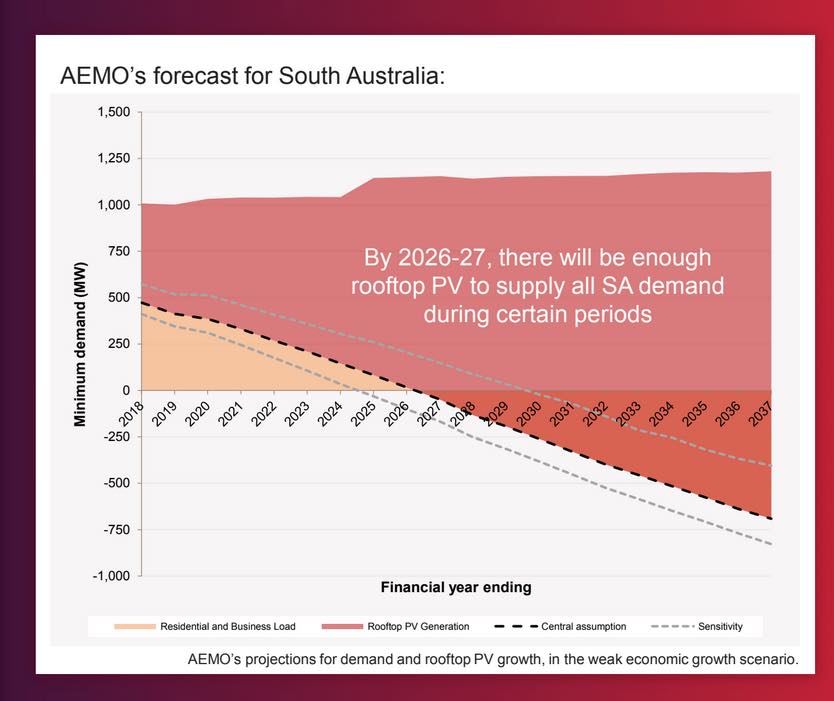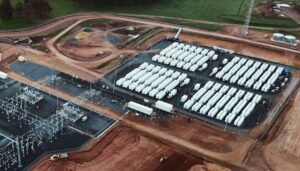The rooftop solar PV systems being installed by Australian homes and businesses could become one of the grid’s greatest assets, making it greener, smarter, cheaper and engaging prosumers in the process.
But as the distributed solar market grows – currently at a record-breaking rate – the reality is dawning on the powers that be that tens of gigawatts of rooftop PV could also represent one of the biggest risks to the grid, if it is not properly integrated and managed.
And according to Dr Jenny Riesz – a principal at the Australian Energy Market Operator, and before that a UNSW research associate whose work focused on focused on high penetration renewable power systems – the time to address this risk is Right Now.
That’s because a failure to act could see AEMO lose its grip on grid control, starting within just five years.
“We are seeing enormous growth in distributed energy resources in our grid,” Riesz told this week’s APVI Asia Pacific Solar Research conference in Melbourne.
And that growth is showing no signs of slowing down. Riesz cites AEMO’s own “quite moderate estimate” projections that rooftop PV, which is at about 6GW now, is headed to around 20GW by 2030. realistically, it will quite probably more, as households and businesses race to hedge against rising power prices and as the technology gets cheaper.
“This is on a system that has a peak demand of only 35GW, so enormous quantities of rooftop PV, and potentially around 5GW of energy storage systems on our grid by 2035,” she told the conference on Thursday.
As AEMO chief Audrey Zibelman has repeatedly asserted, this behind the meter energy generation and storage resource has enormous potential to be harnessed by the market operator, in any number of ways, to help provide crucial grid balancing and particularly peak shaving services.
And extensive modelling by Energy Networks Australia has supported this view.
It showed that by orchestrating the nation’s distributed energy resource (DER), and coordinating the dispatch of it in a sensible way, network charges could be reduced by 30 per cent, annual savings delivered to households, and up to $1.4 billion in network investment avoided.
“So, really important that we pursue these opportunities,” Riesz said. “However, I want to emphasise that this (research) applied to well coordinated DER.
“If we have poorly coordinated DER, you can have quite the opposite effect. Instead of being our biggest opportunity, DER can be our biggest risk and our biggest problem on the grid.
“If we start seeing aggregated action from these systems that is not coordinated in a way that helps system security, it could have a severely detrimental effect, and increase the need for centralised investment. So, really important that we get this right.”
Riesz says that one of the major concerns around unfettered quantities of rooftop photovoltaics on the network is the excess energy that can’t be controlled.
“At the moment there is no framework for moderating the feed into the grid from rooftop PV systems,” she said. “We can turn down the large-scale wind and PV if we have to, but there is no way at the moment to control rooftop PV systems.
And AEMO’s most pressing concern, on this front, is South Australia, where the grid is already, at times, getting half of its energy from rooftop PV systems, and is rapidly heading to a scenario where 100 per cent of demand will occasionally be provided by distributed solar.
Riesz used the below “duck curve” chart to demonstrate why this could cause serious problems.
“You can see, in the blue is where we are at the moment. As we go forward in time, in the dotted lines you can see that demand going strongly negative in the middle of the day,” she told the conference.
“If no action is taken, this will severely affect AEMO’s ability to operate the system in a secure way at these times. So this is a risk to system security that needs to be managed.”
Riesz stresses that, in the early days, the risk posed by this would only really arise during “very, very rare” emergency events, such as extreme weather events and natural disasters, that occurred less than one per cent of the time.
And even then, such emergencies would only pose a risk if they coincided with periods of rooftop solar insolation being very high.
Another major concern for AEMO is the response of the rooftop solar resource to network disturbances.
“To understand that if you have a system that is 100 per cent running on rooftop PV and you have a disturbance like a severe frequency event, or a voltage dip, the response of those PV units is going to entirely dominate the dynamic response of that system,” Riesz said.
“Furthermore we don’t actually really even understand certain components of how these systems will respond, and neither do the manufacturers. When we’ve asked them about some of the less straightforward ways that they’ll respond, the manufacturers themselves don’t know, because it simply hasn’t been tested.”
For example, Riesz points to a voltage disturbance that affected the Adelaide area on March 3 this year, that briefly took out nearly half of the state’s rooftop solar generation.
“There was a severe voltage disturbance in the Adelaide area, and we estimate that something like 40 per cent of rooftop PV systems in South Australia ceased operation, and they were offline for what seems to be several minutes from the poor data that have available on those systems.
“What this means …if you project this forward is that if that happened in the middle of the day … we could be looking at losing a GW of generation in a region that only has 1-3GW of demand, and losing it for several minutes.
“And we simply don’t carry adequate reserves to manage that in SA, nor would that be cost effective to do so.”
So what’s the timeline for addressing these problems? According to Riesz, it’s actually frighteningly short: “Within the next five years or so, we enter the realm where AEMO no longer has the ability to ramp down interconnector flows to SA to zero, if we need to, for some sort of a system security reason.
“And that can happen, for example, if there were bushfires in the realm of those interconnectors, we typically ramp them down to very low levels such that if interconnector is lost, the system remains stable.
“We will no longer be able to do that within a very short timeframe, within the next five years or so. at these times, if we have those events coincident with these times when we have very high rooftop PV.”
Several years after that, Riesz says, around 2025-2030, AEMO would lose the ability to apply its standard measures to manage a forced outage on the network.
“So this is where there’s a fault on some sort of interconnector component, that means that one of the circuits is lost, we then ramp down the flows on the remaining circuit to lower levels such that if it was a credible loss of that circuit, we can then manage that without load shedding to customers.
“We lose that ability around 2025 to 2030. And then by 2035 to 2037, we actually reach the point where even under system normal conditions, we can no longer run the grid within secure limits. We will be overloading network components in these periods with no ability to turn down that rooftop PV.”
But the good news is that there are plenty of solutions. Most of them imminently achievable, using current technology, load shifting methods and software platforms. But they also rely on consumer participation. 
“There is a huge amount that we can do about this,” Riesz told the conference on Thursday. “It’s just that we have to get on and do it. Now. Now is the time.
Key among the possible solutions is increasing daytime demand. This can be done a number of ways, such as shifting hot water clocks from night into the daytime; coordinating the distributed storage “that’s coming in at a rate of notts”; or using electric vehicle charging to mop up excess generation.
“Electric vehicles coming in could enormously help, And we could have other sorts of flexible loads like water pumping, and so on; if we provide the right tariffs and incentives, a lot more of that can be done during the day, to suck up this energy,” Riesz said.
AEMO is also looking at new interconnectors out of South Australia, Riesz says, which “for a whole suite of reasons” are likely to go ahead.
“That would enormously help, because it would give us capacity to export more of this energy from SA,” she said, although adding that this solution was somewhat time limited, in light of the fact that other regions of the NEM are also installing rooftop PV at an enormous rate.
Big batteries were another solution, although Riesz notes that utility-scale storage could be fighting a losing battle against distributed generation.
“I would point out that the Tesla battery that’s gone into SA, 100MW, will only buy us about one year, maybe even only six months at the current installation rates of PV that we’re seeing. And that is the biggest battery in the world right now, so we’re looking at an enormous amount of battery capacity to solve this problem, so it’s probably only a partial solution.”
A further fix would include network assets, such as increased voltage control, synchronous condensers, and potentially even resistor banks to soak up excess energy at times when AEMO doesn’t need it, particularly in parts of the distribution network.
And finally, Riesz says PV feed-in management is going to become “really important.”
“For that rare point in time when we need to moderate that feed into the grid, to keep it within secure limits, we will need the capability to be able to control those systems in some way,” she said.
And this chart below helps illustrate why.

“This chart is showing you the amount of demand response that we might be able to get from a range of different sectors, if we’re really aggressive and ambitious about it,” Riesz told the conference.
“You can see in this yellow brick here, the amount of demand that we would need on the most challenging day in 2035 to soak up the total excess of PV that we’re looking at and keep the system within secure limits. And you can see that, even adding up all of these extra demands sources, we’re still falling short.
“So this is something where we should definitely pursue all of these demand response options, but we cannot rely upon them to be adequate to solve this problem.
“We will need to curtail down some of these systems at these very rare times, to keep the system secure. And we think that it’s probably going to have to involve something like 90 per cent of all PV installed from around 2017 to make this work.
“So this is something where it probably is going to not be an opt in kind of scheme, to make it work get those sorts of participation rates.”
This is interesting to note for the nearly 2 million rooftop solar owners currently out there, and the many more to come.
But making sure it is a win-win for AEMO and consumers will need to be a key part of anything the grid operator comes up with, to avoid the sort of mass grid defection that will be much more doable in the not-too distant future, as battery storage prices continue to fall, and home energy management systems get smarter and easier to use.
As Risez puts it: “Customers want rooftop PV, they are choosing to install it, and we have a responsibility to enable that choice.
“And if we do manage these controllability challenges, potentially starting with understanding how we manage rooftop PV in a more orchestrated way, that can then unlock the orchestration of distributed energy resources more broadly. And that has huge potential for a more efficient and cost effective grid, engaging prosumers in the process.”













